March 5, 2006
MeasureNet is well-represented in the Peachtree State this month. At the 231st National American Chemical Society Conference and Exhibition, there will be two MeasureNet-related presentations, as well as a sizable exhibit hall display:
MeasureNet Implementation at Western Kentucky University. D.B. Dahl, L.L. Pesterfield, E. Houchins
CHED 270, Undergraduate Research Poster Session, Monday, March 27, 11:00 AM - 1:00 PM; Exhibit Hall B4
Western Kentucky University has embarked upon a sweeping improvement of the entry-level undergraduate laboratory program. Specifically, we intend to enhance the undergraduates' learning experiences by: 1.) Providing for a more in-depth consideration of experimental design 2.) Improving our students' abilities to critically evaluate data 3.) Establishing a mechanism to improve our students' scientific writing 4.) Exposing our students to more modern laboratory methods
To accomplish these goals MeasureNet, a laboratory network system, is being implemented. This state-of-the-art system allows for a unique network of independent data-measuring stations operated by a single controller. An important phase of this re-structuring will be the implementation of self-directed experiments into our curriculum. Several outcomes are expected. First, a larger number of experiments will be available for the students to perform. The ease with which the students grasp the procedure will be an indication of how well the concepts were taught or communicated. Students will then be able to interact with peers in a “project-related” lab. The formal writing of reports will be improved due to an enhanced writing component. Data manipulation will also be improved along with a substantial time saving in data collection. An additional benefit will be that smaller quantities of reagents are required thereby reducing waste and associated costs. Results of a 1st semester pilot will be presented.
Assessment of Laboratory Skills Via Practical Examinations Featuring MeasureNet. B.J. Stanton, L. Zhu
CHED 1231, Assessment of Student Learning Pt. II, Tuesday March 28, 9:25 AM; Grand Ballroom B
We have recently implemented Laboratory Practical Final Examinations into the General Chemistry laboratory curriculum. Each student must individually perform a laboratory experiment to answer a central question. This will aid us in assessing whether our students have mastered basic laboratory techniques, and whether we are effectively teaching students how to solve problems and answer questions. Second, as a consequence of Self-Directed experiments, we have observed what we have termed “dominant and recessive” students. “Dominant students” take charge and are responsible for leading their team through the self-directed experiments. “Recessive students” are hesitant to speak up and voice an opinion. In many cases, they are resistant to take a hands on approach in their experiment. Some are intimidated by computers and automation in general. It is our intent to strongly encourage “recessive students” to be more assertive and to become more involved when performing concept/technique and self-directed experiments.
Exhibition Hall Display, Booth 1327, March 27-28th. Stop by and get a T-shirt from the MeasureNet Notable Chemists series.
The 173rd 2YC3 Conference will be held at Georgia Perimeter College, Dunwoody Campus. Visit with MeasureNet's Shawn Brooks Friday and Saturday, March 24-25th. Georgia Perimeter College's Clarkston Campus is a member of the MeasureNet Community (contact the Department of Physical Educaction and Science's Dr. Michael Denniston or Dr. Howard Silverstein for more information). Visit the 2YC3 meetings page for directions and registration information.
> 173rd 2YC3 Meeting Page
MeasureNet Technology Ltd. manufactures patented, network-based data acquisition interfaces for science teaching laboratories. It is a spin-off of the University of Cincinnati's Department of Chemistry and is headquartered in Cincinnati, Ohio. Measurenet's award-winning, PC-reducing design helps reduce laboratory maintenance and operational costs while giving students access to high quality shared UV-vis spectroscopy and an array of innovative probeware. It's acclaimed intuitive design provides improved transparency to enable better science-focused, not technology-focused, learning. Winner of the Ohio Governor's Award For Excellence in Energy Efficiency, MeasureNet networks are found in universities, community colleges, high schools, and vocational training centers across the United States and around the world.
For more information contact:
Len Weibel
Director of Business Development
tel. toll-free: 866-396-6765
lenweibel@measurenet-tech.com
kurutz@measurenet-tech.com

December 28 , 2005
Customers needing to elevate MeasureNet stations out of harm's way but lack room for benchtop stands have a new option. MeasureNet's new Mounting Brackets secure student data stations to available shelving or above-bench conduits that exist in many of today's older teaching labs.
The brackets are custom made to fit the specific dimensions of your bench area. Installation is straightforward and should take no more than a few hours (and a drill!) to outfit an entire 12-station laboratory. The black wooden brackets are designed to house a single station and can mount in a variety of ways depending upon the design of your benchtop. MeasureNet provides all needed mounting hardware.
The stands are priced affordably at $19.99 each plus shipping and handling. They are available for both new orders and previous MeasureNet installations.
[pictured below: (left) MeasureNet's Bjorn Carle, Ph.D. displays typical German-efficiency as he mounts new brackets and (right) the finished product complete with MeasureNet station]
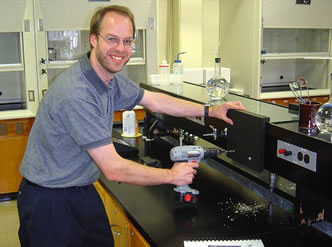
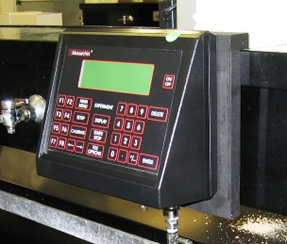
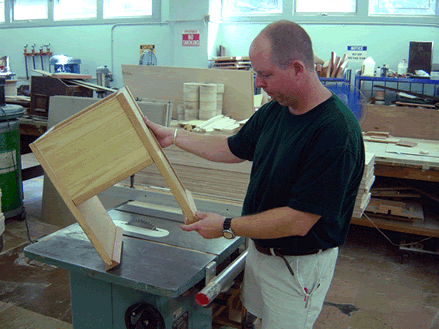
August 20, 2005
Most MeasureNet customers prefer their student interface stations mounted vertically to avoid the knocks and spills typical of an entry-level teaching laboratory. Many newer lab bench designs, however, lack the vertical shelving and piping typically used to mount MeasureNet stations in older labs.
An Ohio-based company has come to the rescue of vertically-challenged MeasureNet users. Near West Woodworks of Cleveland supplies MeasureNet with customized wooden station stands that elevate stations away from the dangers of acids, bases, drops, and knocks. The stands come in both single and double-sided versions and can be built to match the spatial characteristics of a wide range of benchtops.
But there is more than meets the eye to the story of Near West Woodworks. The shop is an enterprise of Spectrum Of Supportive Services—an organization helping individuals with mental illnesses achieve the necessary skills to lead healthy, productive lives. The organization offers a range of employment services, housing, help lines, and consumer-operated enterprises.
Near West Woodworks has resided in the Ohio City neighborhood of Cleveland for over 35 years and employs some 50-60 individuals in programs that range from woodworking and custom picture framing to construction site clean-up. The company manufactures products for the aerospace industry, national window firms, and local universities.
"These guys are consummate role models in the community," according to MeasureNet's Director of Marketing Michael Kurutz. "They manufacture quality stands that are a great value to our customers. But more importantly, they empower, educate, and encourage their clients toward independence. The day-to-day work they've done over the past three decades has made a quantifiable impact in the lives of many."
MeasureNet's relationship with Near West Woodworks is part of an overall effort by the Cincinnati-based educational technology company to source materials and assembly in Ohio to help generate employment and retain tax revenue in the state. "While we could probably save a few dollars by outsourcing production abroad," adds Kurutz, "the communities we live and work in would benefit little. In the case of Near West Woodworks, there's no question we're doing the right thing."
(pictured above: Peter Malquest, Near West Woodwork's Vocational Supervisor inspecting the finished product)
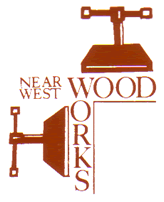

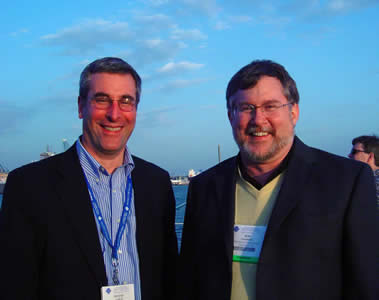
MeasureNet's President Robert Voorhees (right) and Director of Marketing Michael Kurutz (left) will welcome exhibitors to CERMACS 2007 at the Northern Kentucky Convention Center in Covington, Kentucky. The conference is hosted by the Chemistry Department of the University of Cincinnati in conjunction with the local chapter of the American Chemical Society. As exhibit co-chairs of the 38th annual meeting, Voorhees and Kurutz will oversee the registration and logistics of private sector, non-profit, and academic vendors exhibiting at the conference.
"We're great believers in the ACS Regional Conference Program" says Kurutz. "We regularly exhibit in virtually all ACS regions, thus we have a firm understanding of what's needed to make a meeting successful from an exhibitor's perspective. Bob and I will make the greatest effort to maximize exhibitor exposure."
The pair are planning exhibit areas contiguous to conference sessions, while an an evening reception for attendees is being considered for the vendor's area. Additional features proposed include exhibitor-centric poster sessions and opportunities for vendor workshops.
Find out more about exhibiting at CERMACS 2007 here
Information on the Northern Kentucky area is available at www.nkycvb.com/meeting/
Contact Michael Kurutz at kurutz@measurenet-tech.com
AGRICULTURAL / AGRONOMY: Evaluation of Fertilizers, Electrolyte Transport in Roots & Leaves, Characterization of Chlorophyls, Distribution of Sugars by Photosynthesis, Mineral Transport in Various Soils, Determination of Starch MMW in Grains and Feeds, Distribution of Pollutants (Organic and Inorganic) in an Bio-System, Nutritional Evaluation of Grains, Fatty Acid Profile of Vegetable Oils, Monitoring the Grain Milling Process, Characterization of Fats and Oils, Determination of Micro-Minerals in Plants and Soils, Study of Fungi and Molds
BIOLOGY / BIOCHEMISTRY: Measurement of Amino Acids, Evaluation of Plant DNA (joint w/ Electrophoresis), Determination of Bacteria by Cell Wall Carbohydrates, Enzymatic Hydrolysis of Starches by Amylase as a function of MW, Analysis of Vitamin Metabolism in Stressed Organisms, Determining Respiratory Gases in Bio-Sphere / Microcosm Environments, Determining the Changes in DNA from Mutations (using Onion Skins), Monitoring Photosynthetic Reactions, Measuring the Distribution of Nutrition (metabolic) in an Organism
CHEMISTRY: Qualitative analysis, Quantitative analysis, Organic synthesis, Inorganic synthesis; Macro Analytical chemistry (comparison w/ Titration and Gravimetric "wet” analysis for primary component determination), Micro Analytical techniques (compare to classical “spot test” and micro-scale “wet” tests for trace contaminants); General Analytical Spectroscopy & Chromatography teaching; Applications of Analytical Instrumental Chemistry
ENVIRONMENTAL: Detection of Priority Inorganic and Organic Pollutants in Waters (potable, effluent, discharge, estuary, marine) and Solids (waste, soil, landfill); VOC (volatile organic compound) Testing in Waters and Solids, Measurement of Heavy Metals in the Environment, Determination of Hazardous Organic Materials (BTEX Aromatics, Halogenated, PNAs, PCBs), Evaluating the Effects of Pollutants on Organisms in a “Stressed” Environment
FORENSICS: Detection of Lead Contamination in Drinking Water by Solvent Extraction, Evaluation of Lead in Paint, Comparison of Plastics and Polymers, Determination of the Country of Origin of Lumber & Olive Oil, Identification of Drugs, Measurement of Tobacco compounds in Smoke & Extracts, Trace Metal “Fingerprint” of Animal Feeds & Produce, Characterization of VOCs in Household products, Flammable Residues from Arson Cases by Headspace, Heavy Metal Poisoning by Hydride & CV-AAS; Micro-Samples by IR, FLUOR & Scanning Spectorscopy (Textile Fibers)
GEOLOGY / GEOCHEMISTRY: Evaluation of Mineral Species in an Aggregate, Tracking Hydrocarbon Content in Shales and Clays (petrology), Determining Activators in Fluorescent Minerals, Tracking Metal Transport in Hydrothermal Deposits, Evaluation of Water Tables and Mineral Distribution
PHYSICS: Quantum chemistry, Emission Spectroscopy, Absorption Spectroscopy, Fluorescence Spectroscopy, Optical Theory: Monochromator, Diffraction Gratings, Prismatic Dispersion, Aperature / Resolution; Evaluation of the general Electromagnetic Spectrum; Determining the Thermal Effects in Atomic Spectroscopy and Electron Transitions (excitation), Effects of Continuum vs. Narrow-Line Absorption Signals (for Background Correction)
POLYMER SCIENCE / PETROCHEMISTRY: Study of Polymerization, Determination of Monomers and Oligomers in Uncured Plastics, Evaluation of Plasticizers in Consumer Products, Determination of Octane Rating of Gasolines and Fuels, Characterization of Hydrocarbon-based Lubricants and Additives, Evaluation of Mean MW / BP in Crude and Refined Oils
ZOOLOGY / BOTANY: Study of Biochemical Reactions and Metabolic Processes (respiration, excretion, photosynthesis, necrosis); Evaluation of a Bio-Sphere / Microcosm under different Environments, Characterization of Feeds and Fertilizers, Measurement of Cellular Changes in various Organisms in changing Environments
> MeasureNet Fun-Sci™ Experiments by Probe Type
A typical colorimeter is usually a simple, single-beam optical system to measure “color” in the VISIBLE Spectrum of light and provide ABSORBANCE data at a single wavelength. These systems can cost $1,000 or more for stand-alone colorimeters that merely provide simple ABS data… unless you consider the MeasureNet Model MDBC-138 true Double-Beam, Multi-Functional “Colorimeter” based on a unique set of LEDs (Light-Emitting Diodes)... for under $500! The MeasureNet “Colorimeter” is actually FOUR (4) instruments in ONE (1) compact and rugged box… and works as a colorimeter (to make Beer’s Law Curves for VISIBLE Wavelengths), a UV fluorometer (to demonstrate fluorescence & quenching in certain organic molecules), a turbidometer (to measure the turbidity of particulate & colloidal suspensions) and a phosphorimeter (to analyze the phosphorescence [“glow”] of specific materials).
#1) BEER’S LAW ABSORBANCE & KINETIC SPECTROSCOPY =
This unit can be used as a “simple” Colorimeter to demonstrate Beer’s Law using three (3) high-output VISIBLE Light LEDs at 472nm (BLUE), 525nm (GREEN) and 630nm (RED); which cover over 75% of the classic General Chemistry and Analytical Chemistry Laboratory experiments that teach spectrophotometric measurements. The wavelength coverage of these LEDs allows highly accurate relative measurement of almost all the ROYGBIV Colors. The disposable & unbreakable 10mm pathlength, near-UV plastic cuvettes included with the “Colorimeter” can be used from ~300nm (in the near-UV) to over 1000nm (in the near-IR) for analytical measurements… and come with sealing caps to preserve prepared solutions for future tests. Some of the popular Laboratory experiments defined in MeasureNet’s proprietary FUN-SCIence™ Laboratory Programs and its upcoming “Chem-Lab Library” that provide an excellent framework to create or supplement YOUR OWN Academic Lab curriculum program for Gen Chem, Analytical or Student Research are:
Red / Blue / Green Colorimetric ABS Data for Beer’s Law plots:
• Test for Mineral IRON in your Daily “Eats”… check your Cereals, Breads and special Treats!
• Unsaturated FATS can be easily seen… just get a purple Color using some IODINE!
• Evaluation of Nutritional Food Proteins… React it to get a “BLUE” and see what can be seen!
• Consistency of M&M and Skittles Candy Colors: Is the "blue" true blue or “faux” to you!
• Changing “Colors” of some pH Dyes… [H+] makes them look *new* to our eyes!
• General Colorimetric Assay… for ANION (X, PO4, SO4, NO3, NO2, etc) saves the day!
Unlike most other popular Spectrophotometers… even those costing over $5,000… the MDBC-138 is a TRUE Double-Beam Optical System… and provides a reference cell to “blank” out the reagents used to create a very stable ABS reading for several Organic Reactions. Data from these Labs can be used to calculate rate constants, equilibrium factors and reaction conditions (for thermal, ionic and electrochemical variables). This is a MUST for making accurate kinetic experiment tests. A few of them from our “Library” include:
Dual-Beam ABS Data for Kinetic Measurements:
• The Iodine Test for Starches is GREAT… just Hydrolyze with Amylaze to get a Kinetic Rate!
• Perform REDOX “Clock” Reactions in School… and show Students that Chemistry is Cool!
• pH-based Hydrolysis of p-nitrophenylacetate Ester… try it out in your Lab this Semester!
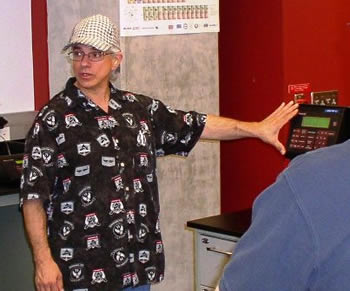
MeasureNet’s Fun-Sci™ Experiments
Listed below are a few "fun" and "interesting" (aka: non-boring!) experiments developed to provide creative & effective teaching “tools” in laboratory environments using MeasureNet instrumentation—from general College Chemistry to Advanced University Research... as well as for High School Outreach (“Science-In-Motion”) programs. They focus on topics that students deal with or are concerned with everyday, and thus inspire them to remember what they did during the experiment. Please look for (and contribute to) our web-site (www.fun-sci.com) soon!
> Voltage Probe
> Voltage Measurement - Liquid Chromatography (LC)
> Voltage Measurement - Gas Chromatography (GC)
> Temperature Probe
> pH electrode (with MeasureNet Drop-Counter)
> Pressure Transducer
> Spectroscopy - UV-vis
> Spectroscopy - AA
> Spectroscopy - IR
> Colorimetry / Fluorimetry / Turbidity / Luminescence with Multi-Function Colorimeter
[F1] Voltage Measurement Probe (+/- 2.5V range with < 0.1µV Sensitivity):
• The “Human” Storage Battery: Measure your personal “power” levels… People are Ionic!
• Time for Fruit: Get a charge from Metal Strips inserted in various Fruits… and power a Clock!
• Fuel Cell Technology: Can H2-Power really work… or is it really just full of hot Air?
• Indirect Conductivity: Personal “resistance”… Do Electrons “move” you?
• Culinary Conductivity: Are Foods called “Salt-Free” really what they’re meant to be?
• Electrolytic Activity the “Electromotive” Metals: Selective Corrosion,,, “sacrifice” one to save others!
[F1B] Voltage Measurement Recorder (+/- 2.5V range for Analog Instruments):
-=> Liquid Chromatography (LC) =
• Composition of SODA (or “POP”) : Can you have negative calories? Is the Caffeine “FREE” free?
• Anti-Oxidants in Cereals: Do "Snap" and "Crackle" still "Pop"? Finally "see" your BHT, BHA, TBHQ!
• Determination of Scoville units for Hot Peppers: How hot is "hot"?… check for the Peppery Peaks!
• Coffee, Caffeine and You: How non-Caf is your Decaf? How Acidic is the “Pot”? Let's brew & scan!
• Measuring the STUFF in Tobacco Smoke: It's no Joke to breathe Second-Hand Toke!
• Be a Drug Agent like on CSI… “Separate” some Dope and find out why! (It’s “bad” for you!)
-=> Gas Chromatography (GC) =
• Put the “kibosh” on some Mouthwash! Some leave your Teeth CLEAN, other make you turn GREEN!
• Get the Octane Rating of your Gasoline: Look at what you put in your Machine!
• Measuring Alcohols from Fermentation Broths: Is it Compost or is it Beer… not easy to tell, I fear!
• Evaluating VOC (Volatile Organic Compounds): Is your Paint Thinner an Environmental Winner?
• Determination of Essential Oils in Cosmetics by Headspace: Basking in Nature's Complexities!
• Combustion Engine Gases: Put your Cars in proper Classes by H-Cs, Water, COx, NOx, SOx, etc.
[F2] Solid-State Digital Temperature Probe (-50 - +125°C range)
• Juice-Can Calorimetry of Potato Chips: What you learn here will make your Tummy flip!
• Measure the Heat Capacity of “Polar” WATER vs. “Aliphatic” MINERAL OIL… which will Boil?
• Testing Specific Heat of Solids: Ionic Salt / Covalent Sand / Organic Polymers… which stays warmer?
• Heats of Reactions for Acids and Bases… find some “Heat Energy” in the strangest places!
• Soccer Injuries or Winter Days… those “Hot” & “Cold” Packs come into play! See Cool Hot stuff!
• Conservation of Energy and Matter: Hot & Cold will mix to “Balance out”… without a doubt!
• Be a Fire Safety Engineer… check Thermal Conductivity of Building Material & minimize Fire-Fears!
• Freezing Point Depression and Boiling Point Elevation… test them out on your Work-Station!
• Micro-Wave Susceptibility of Different types of Foods and Materials (“Lossiness”)
[F3] pH (0-14 units), mV (I.S.E. & Re-Dox); in conjunction w/ M-Net Drop-Counter:
• Measuring the Acetic Acid in Various Vinegars: Which “Sour” has the most “power”?
• Adjusting a Solution pH with a Buffer… getting any changes will be a lot tougher?
• Titrations with Acids and Bases: Protonate the Indicators in different places! (also w/ Spectro or Color)
• Determining the pKa for many types of Acids… Weak, Strong and Poly… good golly!
• Test the varying pH’s of Clam Chowdas… it’s “higher” in Boston, so say it Louda!
• Culturing Molds at different pH ranges: Is it contained or spread like the Andromeda Strain”
• Counting the Drops in your Titrations make these analyses a cause for Celebration!
• Titrate the Anti-Oxidants in your TEA… Compare Black, Green and White; what do you SEE?
[F4] Pressure Transducer (+/- 750 torr) & Tension / Force Gauge (Push/Pull to 45lbs):
• Learn to “obey” your Ideal Gas Laws… but test them here to find some FLAWS!
• A “Closed” System to study Plant Respiration… use Partial Vacuums in this Bio-Investigation.
• Evaluating the “Bubbles” in your Carbonated Soda Pop… do they hang around, or is your Drink a Flop?
• Modulus of Expansion based on Heat & Cold… test some Materials, if you’re so bold!
• Test GREAT Variations in Surface Friction… learn if Lubrication is a real Fact or just Fiction!
• Angular Vectors affect how “things” slide… so do your own studies & report them with pride!
• Small “Explosions” can create Pressure Waves… do this Lab only if you’re Brave!
[F5] Spectroscopy (shared Network Spectrometers), CCD / Diode Array & Monochromators:
-=> Scanning UV (Ultra-Violet) – VIS (Visible) Colorimetry:
• Examination of Extra Virgin Olive Oil: Are they "naturally" worth the extra money?
• Checking the Consistency of M&M and Skittles Candy Colors: Is the "blue" true blue or “faux” to you
• Measurement of UV-Blocking in Sunscreen Lotions, Lip balms & Sunglasses: See what you can't see!
• Determination of Rare Earths by High-Resolution absorbance peaks: Analyze Cigarette Lighter Flints!
• Spices of Life: See the "true colors" of Nature's products by solvent extraction!
• Evaluation of Food Proteins… React it to get a Blue COLOR and see ehat can be seen!
-=> Atomic Absorption Spectroscopy (AAS):
• Determination of Minerals in Vitamin Tablets: Are you "Absorbing" what you pay for?
• Checking Hardness of your Drinking Water: To Scale or Not to Scale?
• Get the LEAD Out!: Classic chelate-extraction to measure Lead in Drinking Water...R U Safe?
• Calcium & Minerals in Milk: Good for the Bones… or an Analytical Unknown?
• Ion-Transportation in Plant Tissues… an important topic In Fertilization issues!
-=> Infra-Red Spectrometry (IR):
• Adhesive Tape - The Poop on Glue & You: ATR/IR to get the skinny on your sticky!
• Evaluation of Synthetic and Natural Perfumes by Gas-Cell: Tell K-Mart from Chanel!
• Characterize the Plastics for Recycling by ATR: Keep your Olefins separate from your Polyesters!
• Fats Where Its At: Butter, Margarine and the "Fakes"; how bad is YOUR Fat?
• Hydrocarbons from Gases to Greases: Its "chain length" that makes these pieces!
• Oils Well that Ends up in your Engine: Is Oil “Oil”; Scan & see if its H-C, Polyester or Triglyceride!
[F6] Colorimetry / Fluorimetry / Turbidity / Luminescence (assorted LED-based technologies):
-=> Red / Blue / Green Colorimetric Date = Single ABS Values & Kinetics
• Test for IRON in our Daily “Eats”… check your Cereals, Veggies Breads and even special Treats!
• Reducing Sugars by Fehlings Test... great for Diabetics, Atkins-Diets and all the rest!
• Evaluation of Food Proteins… React it to get a Blue COLOR and see what can be seen!
• Checking the Consistency of M&M and Skittles Candy Colors: Is the "blue" true blue or “faux” to you
• Changing “Colors” of some pH Dyes… [H+] makes them look *new* to our eyes!
• The Iodine Test for Starches is GREAT… just Hydrolyze with Amylaze to get a Kinetic Rate!
• General Colorimetric Assay… for ANION Species (X-, PO4, SO4, O3, NO2, etc) saves the day!
-=> Filter-Based Fluorimetry = Single “EMISSION” Value
• “Zap” some UV against Chlorophyll from things that Grow… and see what makes it eerily Glow!
• The Highlights of Highlighting Markers: How bright is bright? Is the Package LABELLED right?
• Measurement of Algae/Plankton in Lake/River/ /Ocean Water samples: How healthy is your water?
• Evaluation of Cigarettes & Second-Hand Smoke: Nicotine for the Masses in your Breathing Gases?
• Analysis of Alkaloidal Material: Don't do drugs!....., but do drug analysis! Let's start with Quinine!
• Measure Amino Acids in “Energy Drinks”… Are their labels Accurate… or does their Data Stink!?
• Check Ground-Water “Plumes” with Fluoresceine… and Water-Table extracts will also be green!
-=> Turbidity (“Nephelometry”) = for Relative Comparison at Single values & Kinetics =
• Environmental Testing of “Settleable Solids” for River / Stream & Estuarial Waters
• Rate of Reaction of Silver Ion + Chloride Ion to form AgCl precipitate… Kool Kinetics!
• Visit Princeton University to see the Nassau Clock… but do this Lab in right at home (or School!)
• Test for IRON in our Daily “Eats”… check your Cereals, Veggies Breads and even special Treats!
• The Highlights of Highlighting Markers: How bright is bright? Is the Package LABELLED right?
• Measurement of Algae/Plankton in Lake/River/Ocean Water samples: How healthy is your water?
-=> Luminescence (“Phosphorescence”) = for Relative Comparison at Single values & Kinetics =
• Check out these Glow-in-the-Dark Plastics… some are made of Material quite Fantastic!
• Bio-Luminescent Algae and Bacteria are found in “Healthy” Waters… See anything “Fishy”?
• “UV” from Light that causes the “Glow” & Photon Motions… “Block” some with SPF Lotion!
• “Photo-Luminescent Plastic” is used in New York City… for buildings at risk by Homeland Security!
• The Luminol “Light Stick” reaction… used Organic Oxidation to set those Photons in action!
> Return to Top
> MeasureNet Fun-Sci™ Projects by Departmental Discipline